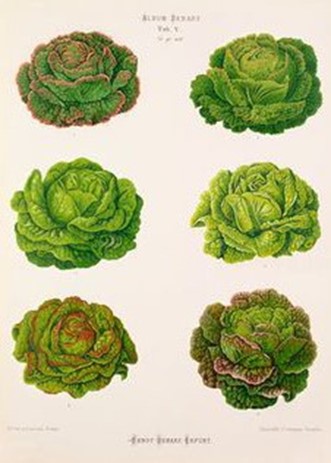Growing Lettuce
A quick glance at a seed catalog or packaged seed rack will reveal a wide assortment of healthy lettuces and salad greens that have hit the home garden market recently. Lettuce is a popular choice for home gardens for its ease to grow, it’s nutritional value, and its delicious flavor and texture. Lettuce can be grown all season long and harvested consistently, but it does prefer cool, moist weather, and many varieties will bolt to seed under stressful heat conditions. There are four types of lettuce, which include: crisphead, butterhead, loose leaf, and romaine. Grow lettuce in cool temperatures in full sun for optimal flavor and quality.

Soil Preparation
Lettuce prefers a loose, sandy soil that is rich in organic matter, well drained, and not too heavy. They also need full sun exposure. Before planting, incorporate 2-3 inches of well composted organic matter and 1-2 lbs of all-purpose fertilizer (we recommend “That’s All it Takes” complete fertilizer) per 100 square feet and work them into the soil to a depth of 4-6 inches. Heavy, clay-based soils must be amended with compost and organic matter to encourage and allow good root development. If you have heavy soil, we recommend 4-6 inches of organic matter and 50 lbs of Utelite or Zeolite per 200 square feet added to the soil each fall for multiple years to increase drainage and nutrient availability. Over time, you can create a better growing environment for your garden plants to thrive in and produce.

Planting
Lettuce can be planted from seed or transplant. It is easiest to grow from seed because of its quick germination in cold soils. Seeds should be planted ¼ inch deep in rows 12-18 inches apart. The seeds will germinate in 7-10 days but germination drops when temperatures exceed 75 degrees, so plant in very early spring or late summer/early fall for best results. Once the seed germinates and plants reach about 1-2 inches tall, thin the individual lettuces to about 8-12 inches apart to reach maximum growth and head development.
If you want smaller, leafier lettuces, thin plants to about 1-2 inches and harvest when they are small and tender. Plants are usually ready to harvest in 50-75 days. Don’t forget, fall is one of the best seasons for leafy greens! Plant again in August and September to maximize the potential of your garden space.
Mark Suggests:
“Plant lettuce thinner than you think! Each little seed will become a large cluster or head of lettuce. Plant lightly in the beginning and you won’t waste seed by thinning later.”
Varieties
With so many great varieties to choose from, here are a few of our favorite varieties of lettuce: 5 Way Blend, a mixture of 2 red leaf varieties, romaine, butterhead, and Simpson lettuces.
Colorful, tasty, and nutritious, it’s one of our all-time favorite mixes; Esmerelda Buttercrunch resists heat and heads up quickly; Plato II and Outback are tall, heat tolerant romaines with sweet, crunchy leaves; Lollo Rossa, Red Romaine and Royal Red, round out our selection of heat resistant, sweet red leafed lettuces.
Water
Water Lettuce frequently and consistently applying 1-2 inches per week. Water fluctuations will yield tough and bitter leaves.
Fertilizer
Side dress the rows with nitrogen (20-0-0) applying 1/4 cup per 10-foot row 4 weeks after planting to encourage growth.
Common Problems
Lettuce is frequently infested by slugs, spider mites, aphids, leaf miners, caterpillars, mildew, leaf blight and verticillium wilt. Apply insecticides such as Ferti-lome Broad Spectrum Insecticide or Triple Action (Organic) for insect outbreaks, and a safe fungicide like Copper Soap as needed to control disease issues. Practice crop rotation to avoid verticillium wilt and blight.
Harvesting
Lettuce can be harvested at any stage of growth. Strip the outer old leaves off first to continue to let new inner leaves to grow. When cutting and harvesting entire heads, remove and compost the shallow root system to allow other heads more room to develop. Crisphead and Romaine lettuces are best when heads are firm. Harvest leaf lettuces before seed stalks form. As summer temperatures rise, almost all lettuces, even the most heat tolerant, will become bitter and go to seed. Fall crops last longer before seeding and can be harvested for an extended season. Rinse and pat leaves dry and store in the fridge for up to a week.


